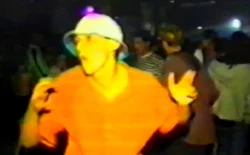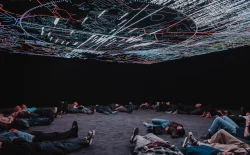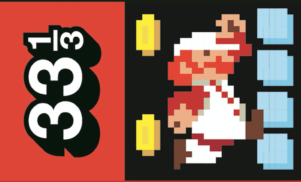Yesterday we counted down the 100 greatest video game soundtracks of all time and Koji Kondo’s score to Super Mario Bros. ranked unsurprisingly high. Today we have an exclusive excerpt from 33 1/3‘s upcoming book about Kondo’s score by Andrew Schartmann.
1–3 Kondo’s Compositional Philosophy
Over the years, countless interviewers have asked Kondo to single out the music of which he is most proud. His choice is always the same: the original Overworld themes from Super Mario Bros. and The Legend of Zelda. Many of us would agree that these are the tunes we remember best, but it seems odd for a composer to locate his greatest achievements in the nascent years of his art. What about the steady lifting of compositional constraints afforded by advances in technology, which allowed Kondo to expand his “orchestral” palette, write considerably longer scores, and wield precise control over dynamics, rhythm, and other facets of the musical canvas? Wouldn’t this freedom make for better work in the hands of a good composer? Not necessarily. Despite appreciating the variety of sounds now available to him, Kondo views technological advance as a double-edged sword: “[P]eople sometimes think, ‘well, we’ve got all of this.’ So rather than having to create something that’s really great, they . . . rely heavily on technology, or say, the instrumentation.” In many ways, the stringent limitations of the 8- and 16-bit systems (i.e., the NES and SNES) fostered innovation to a degree unrivaled by modern consoles. The point, however, is not to tally bells and whistles, but rather to focus on the underlying substance of the music. And so we arrive at Kondo’s compositional philosophy.
Although Kondo’s more recent work is painted with lush orchestral colors, his philosophical approach to writing music remains constant. As nearly every interview with the maestro reveals, writing a catchy tune is only half the battle. The other half involves matching the music to both the game environment and the experience of the player. This might seem obvious today, but when Kondo came onto the scene, video game music was still fully steeped in its arcade origins. Sound functioned primarily to attract the attention of customers and to provide background filler for gameplay. A tight bond between sound, environment, and gamer had not yet been formed. In an effort to create this bond, Kondo demanded that his music fulfill two principal functions: (1) to convey an unambiguous sonic image of the game world, and (2) to enhance the emotional and physical experience of the gamer.
The first of these functions seems relatively straightforward: compose music that gives the player a general sense of the environment. As you’ll read in the second part of this book, Kondo does this (in part) by creating a sonic lightness/darkness binary. By using rhythm, harmony, melody, and form in diff erent ways, he creates two different “sound worlds” — one that is bright and fluffy, and another that is dark and heavy. But Kondo doesn’t stop there. He pushes this function one step further by coordinating his music with the animation of various on-screen characters, such that their movement corresponds in some way to the rhythm of the music. This innovation was made possible by Nintendo’s unusual development process. As Kondo recalls, “At Nintendo, we were able to start working on the game as soon as the rest of development was ramping up, so we’d be working in parallel with them. I know in some cases other developers have hired someone to do the sound after a game was pretty much done, so the results and the process were … different.” Inspired by this highly collaborative working environment, Kondo eventually formalized his greatest contribution to video-game music — the second of the two principal functions listed above: in Kondo’s view, the relationship between sound and physical movement should not be restricted to on-screen animation; it should extend to the gamer him or herself.
Despite Kondo’s groundbreaking contribution, it would be dishonest to ignore important precursors to the idea that music can enhance a player’s physical and emotional experience. Space Invaders is perhaps the earliest example of a game whose music elicits a strong emotional response. The tune is simple (a four-note descending scale that repeats over and over again), but the fact that it speeds up as the invading aliens approach is revolutionary. In Space Invaders, music is no longer just a background effect; it is part of a visceral gaming experience — one that affects the heart rate of anyone who tries to defend the world against Taito’s pixely intruders. The ‘Time Warning’ theme, which initiates a twofold increase in tempo to nudge Mario toward his goal, provides an obvious parallel in Super Mario Bros., but whether or not Space Invaders had a direct influence on Kondo is debatable. The general sound, however, was surely in his ear. Not only did Kondo play the game growing up, but its unprecedented success also made it impossible for anyone in the field to ignore. In fact, one could argue that a large part of that success was due to the game’s innovative use of sound. When asked to explain the mania surrounding Taito’s blockbuster smash, the company’s import manager S. Ikawa emphasized the game’s “feeling of tension” — a tension created primarily by the music.
No matter the reasons for the success of Space Invaders, the game’s latent embodiment-of-music aesthetic became a central pillar of Kondo’s compositional philosophy. In Super Mario Bros., Kondo developed that philosophy and applied it on a much larger scale. Instead of using music to incite a particular emotional response (e.g., using faster notes to increase tension), he tried to anticipate the physical experience of the gamer based on the rhythm and movement of gameplay. This is much less abstract than it sounds.
Imagine yourself at Nintendo during the development of Super Mario Bros. You’ve been asked to compose music for the game, and the developers have invited you to try one of their working prototypes. As you play through the level, you get a feel for how Mario moves through his environment: your body sways as Mario jumps, stops, runs, changes direction, and so on. You also notice the movement of other creatures: how the Goombas’ feet move, how oft en Piranha Plants open their mouths, and so on. After a while, your body starts to beat in time with the game — you have internalized the rhythm of its movement. Having done so, you head back to your studio and translate the movement of your experience into sound.
It is exactly this innovation that Kondo stresses in his many press appearances: “the [Super Mario Bros.] music is inspired by the game controls, and its purpose is to heighten the feeling of how the game controls.” In essence, if music does not reflect the rhythm of the game, and, by extension, that of the gamer, it becomes background music. Unfortunately, it’s quite difficult, if not impossible, to identify the exact mechanisms by which Kondo’s music meshes with a player’s movement. But that doesn’t relegate his philosophy to the realm of esoteric hullaballoo by default. When I play Super Mario Bros., the music is always eerily in sync with my on-screen marionette. Individual experience aside, Kondo was convinced that game sound could lessen the gap between Mario and the hands that move him. With Kondo’s visionary techniques, players do more than control a character on screen; they form an intimate bond with it — a bond forged by the motional spark at the heart of Kondo’s music.
From this perspective, the curiosity that initiated our discussion becomes far less curious. Why does Kondo take the most pride in his earliest hits? Because it was in these early pieces that he first understood how he was different from those who came before him. More than just a handful of catchy tunes, Super Mario Bros. is the cradle of Kondo’s lifelong contribution to video-game music. So it is only natural that he should cherish it as he does.
33 1/3: Super Mario Bros. will be out May 21 via Bloomsbury. Pre-order it here.



















![180 Studios presents new Ryoji Ikeda installation, data-cosm [n°1]](https://factmag-images.s3.amazonaws.com/wp-content/uploads/2025/10/ryoji-ikeda-data-cosm-1-250x155.webp)










